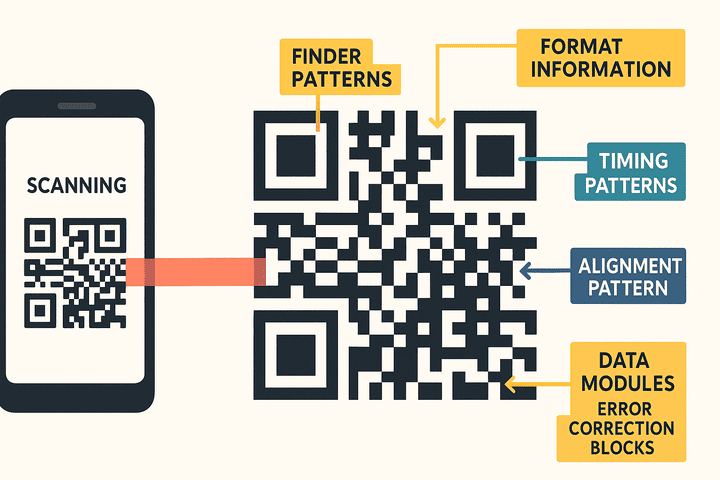How QR Codes Work: A Deep Dive

Table of Contents
Introduction
QR code, short for “Quick Response code,” is a type of two-dimensional matrix barcode invented in 1994 by Masahiro Hara at Denso Wave. It consists of black square modules arranged on a white background, enabling rapid data capture by imaging devices. Unlike one-dimensional barcodes, QR codes store information both horizontally and vertically, significantly increasing their data capacity and scanning speed.
History
Developed to streamline automotive parts tracking, QR codes were released by Denso Wave as an open standard in 1994. The design was inspired by the alternating black-and-white counters of the game Go, optimizing for fast detection and orientation in manufacturing environments. Since then, QR codes have evolved to include variants like SQRC (Secure QR) and Frame QR to address security and design needs.
Structure of a QR Code
A standard QR code integrates several functional patterns to ensure reliable scanning:
Finder Patterns
Finder patterns are the large 7×7-module square patterns located at three corners (top-left, top-right, bottom-left). These markers help scanners detect the position, size, and orientation of the code, even against complex backgrounds, by recognizing their distinctive 1:1:3:1:1 ratio structure.
Separator
Separators are quiet zones—whitespace areas—surrounding each finder pattern. They prevent misinterpretation by isolating the finder patterns from adjacent modules.
Timing Patterns
Timing patterns are alternating light-and-dark modules forming dotted lines between the finder patterns. They define the coordinate grid of modules, allowing scanners to determine module dimensions and layout.
Alignment Patterns
Alignment patterns are smaller concentric square patterns placed throughout the code (in versions 2 and above). They correct perspective distortions by providing reference points for curved or skewed surfaces. The number and position of alignment patterns vary by code version.
Format Information
Format information encodes two critical parameters: the error correction level and the data mask pattern. Stored in specific areas adjacent to finder patterns, it is protected by a BCH error-correcting code to ensure accurate reading under adverse conditions.
Version Information
Version information specifies which of the 40 QR code versions (sizes) is in use. It appears only in codes larger than 21×21 modules and includes data on mask patterns and error correction schema.
Data and Error Correction Codewords
The remaining modules encode the actual payload and error correction codewords. QR codes employ Reed-Solomon error correction, allowing recovery of up to 30 % of damaged code modules, making them robust against scratches, stains, and wear.
Encoding Data into a QR Code
Encoding Modes
QR codes support four primary data encoding modes: numeric (digits only), alphanumeric (digits and letters), byte (binary data), and Kanji (Japanese characters). Each mode optimizes storage efficiency based on content type.
Data Masking
Mask patterns are applied to the raw data modules to avoid problematic patterns (e.g., large areas of same-colored modules). One of eight predefined masks is selected based on which yields the lowest penalty score, and the chosen mask is recorded in the format information.
Module Placement
Data and error correction bits are placed into modules following a zigzag pattern, starting from the bottom-right corner and moving upwards and downwards alternately, skipping functional pattern areas. This systematic placement ensures consistent encoding across different code versions.
Decoding Process
When a QR code is scanned, the reader:
- Identifies the finder patterns to locate the code and determine its orientation.
- Uses timing and alignment patterns to reconstruct the module grid accurately.
- Reads the format information to discover the error correction level and mask pattern.
- Applies the mask to recover the original data modules.
- Decodes the bit stream into codewords and applies Reed-Solomon error correction to fix any damaged bits.
- Parses the resultant data according to the encoding mode to retrieve the original information.
Common Use Cases
As of 2024, QR codes power many applications: they can display text, launch web pages, add vCard contacts, connect to wireless networks, and compose emails or text messages. They also underpin mobile payment systems and loyalty programs.
Conclusion
By combining structural patterns, data masking, and robust error correction, QR codes deliver a fast, high-capacity, and resilient solution for encoding information. Understanding their inner mechanics empowers you to create effective, scanner-friendly codes for any application.